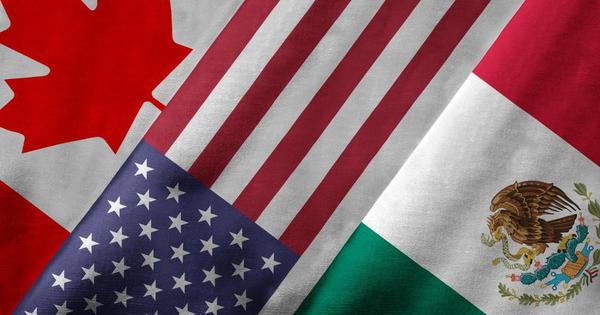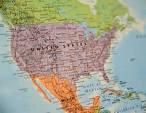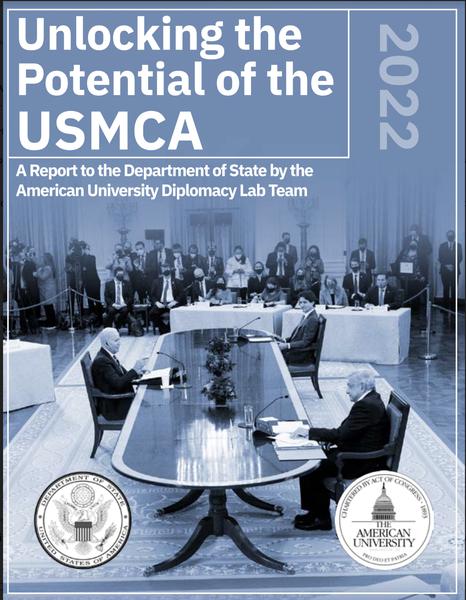August 31 2022
Study: Unlocking the Potential of the USMCA
This report was done by a group of seniors at American University's School of International Service as part of the State Department's Diplomacy Laboratory program, working with retired Ambassador Wayne. Here is the Executive Summary:
The United States-Mexico-Canada Agreement or USCMA is now in its third year of implementation. Notably, trade across North America has surpassed pre-pandemic levels growing to a total of $1.26 trillion in 2021 or $2.6 million a minute.i To add perspective, a record 75% of Mexican and Canadian imports came from the US in 2021. Both countries are also the US’ largest trading partners accounting for over twice trade with China.
The trade ministers and their teams are deeply engaged in a wide range of issues as was evident in the agenda for July meeting in Canada This agenda includes not only hard trade and investment issues but also how to make USMCA more inclusive of communities that are traditionally underrepresented in trade.ii USMCA has particularly won kudos from US congress for progress on use of the new Rapid Response Mechanism for Labor Complaints which has been used five times as of August 2022.
Despite the good news and evident progress in the broad trade and investment relationships, there remain serious disputes and problems to work through over the months and years ahead. For example, the United States, supported by Canada, on July 20 requested consultations under USMCA over Mexico’s energy policies and related treatment of private sector investors at the expense of state-owned electricity and oil and gas enterprises. This action followed a series of private conversations where these concerns were raised. Without significant progress during the period of consultations, the US could seek creation of a dispute settlement panel and potentially win the right to sanction Mexico if does not change its policies/practices. Progress on such divisive issues and effective use of USMCA’s dispute resolution mechanisms are important to demonstrate the credibility of the agreement before the agreed review of USMCA’s performance in 2025-26.iii
It is important to recall that USMCA was negotiated to address emerging challenges facing 21st century international trade and to provide a much-needed update to its predecessor, the North American Free Trade Agreement (NAFTA). From the increasing relevance of the digital marketplace to progressive shifts in policy toward encouraging development and training of workers, the USMCA includes provisions to help modernize the trilateral trade relationship. As USMCA enters its third year, a number of areas within the agreement are also under scrutiny with questions about enforcement or interpretation by one of the parties, and in others because of a desire to understand the effects the new agreement is having on the economies of all three countries (e.g. in the auto sector).
The US, Mexican and Canadian governments have also agreed on goals that go beyond just increasing trade flows and commercial activity to include such factors as more inclusive participation in trade across North America and support for democratic labor rights practices. This signals that the metrics for measuring USMCA’s “success” will include a range of factors beyond simple trade and investment numbers, and some will likely be hard to quantify.
To better unlock the potential of the USMCA, this report recommends that the governments of the United States, Mexico, and Canada take specific actions that can help strengthen trilateral commerce and improve upon some of the disputed and/or flawed aspects of the deal. One of the key challenges in implementing USMCA is accounting for the needs of the many sectors involved in North American trade and co-production and the wide array of stakeholders involved. The diversity of stakeholders and audiences impacted by USMCA, and North American commerce demands both concrete solutions to problem areas and effective public outreach by the three national governments beyond what is being done at present.
The authors studied the USMCA document that entered into effect in July 2020, spoke with a range of experts and industry leaders, and analyzed a wide selection of studies and policy publications. Building on this research, the team recommends the following priorities, presented largely from a United States perspective:
Digital Trade, SME Engagement, and Cybersecurity Cooperation
● Establish a North American Digital Trade Council to help coordinate and direct progress.
● Continue and increase dialogues and stakeholder outreach toward SME e-commerce development.
● Achieve SME empowerment and digital inclusion through capacity and skills development programs.
● Increase efforts to quantify and measure digital trade.
● Hold Mexico and Canada responsible for data localization violations.
Labor Democracy and Workforce Development
● Track reform progress using a shared database which will support US and Canadian labor implementation assistance programs aimed at supporting Mexican reforms.
● Review and potentially revise Labor Dispute Settlement mechanisms during the USMCA 6-year review.
● Collaborate further on forced labor.
● Assemble a Forced Labor Task Force under the Labor Committee.
● Move to adopt real-time labor data collection and expanded credentialing programs by all three federal governments.
Automotive Rules of Origin
● Expedite a resolution of the current dispute in accordance with USMCA’s Article 31.6 over the interpretation of Core/Super-core Roll-up, or content tabulation.
● Work constructively with suppliers and automakers to provide them with more time to collect and report the content requirements and related information necessary for automakers to fully comply with USMCA provisions.
● Streamline the USMCA compliance and certification procedures based on implementation experiences.
● Create further incentives for consumers to purchase electric vehicles sourced in North America, rather than proceeding unilaterally.
Agriculture
● Use all available means so that Mexico adopts a regulatory framework for evaluating GMOs, as stated in USMCA’s Article 3.14.4.
● Launch a multi-agency effort (USTR, U.S. Department of Commerce, USDA, and others as appropriate) to engage in active discussions regarding the long-standing differences over tomato trade with stakeholder groups and Mexican officials to find a resolution to the dispute.
● Continue working to reduce tariffs on Canadian softwood lumber to comply with previous trade rulings, lower U.S. housing prices, and to avoid a dispute settlement complaint by Canada under USMCA.
Good Regulatory Practices (GRP)
● The GRP Committee established by USMCA should meet.
● Harness emerging technologies for conducting Regulatory Impact Assessments (RIAs).
● Take initial steps toward regulatory alignment – data collection, transparency, and identifying priority sectors, with the goal of having robust collaboration underway by the first USMCA review starting in 2025.
Environment and Energy Policy
● Task the new Environmental Committee with creating a strategic plan on climate change, including implementable goals for the pre-existing Commission for Environmental Cooperation (CEC) regarding climate cooperation.
● Create a dialogue among North American peers regarding increasing funding for the CEC to ensure the agency has the funds to implement climate programs while not interfering with existing programs and day-to-day functions.
● As allowed in Article 1.3.2, begin negotiations regarding the addition of the Paris Climate Agreement to the list of multilateral environmental agreements.
● Increased cooperative capacity should be allocated towards harmonizing regional energy efficiency standards as established in Article 12.D.4.
● Develop an agreed US policy framework for addressing and influencing the Mexican government’s energy policies and practices that violate USMCA. Coordinate closely with Canada. Pursue dispute settlement as needed.
● Utilize the USMCA’s Competitiveness Committee to help establish a dialogue regarding North American energy cooperation and regional energy competitiveness.
Public Face: Public Outreach, Transparency, and Public Education
● Acknowledge current limits in public outreach and communications capacity within the USG, including USTR, and create a USG inter- agency working group to devise a more effective public outreach strategy, including to stakeholders as well as the broader public.
● Given similar capacity limitations in the Mexican and Canadian governments, create a standing working committee on public outreach and communications either directly in the USMCA under the Free Trade Commission or perhaps indirectly through coordination mechanisms (e.g., North American Leaders Summit working group).
● In preparation for and during the first sunset review beginning in year five, identify possibilities for more robust and coordinated public communication and outreach efforts regarding USMCA and its benefits for the public.
Emergency Coordination: The authors welcome the decision announced by trade ministers at their July meeting to set up a mechanism under the Competitiveness Committee that can help maintaining trade flows in emergency situations. This is essential for all three countries, given the size and importance of trade flows. With recent examples where cross-border trade was disrupted by a range of unexpected developments from the pandemic to political decisions, this new mechanism can help bolster the other efforts among the three countries to modernize and develop cross border infrastructure, improve border crossing processes and deal with emergencies.
The authors understand that unlocking the potential successes of USMCA will take “whole of government” efforts by all three governments, including the work of foreign ministries, and a range of other agencies. Successful coordination will be challenging in the United States, Canada, and Mexico, especially when involving all the sub-federal governments that must play a role. Yet, the authors came away from its work confident that pulling together, the full potential of the USMCA can be unlocked. Similarly, good public outreach and regular conversations with USMCA’s many stakeholders across the agreement’s three nations will help improve the benefits that accompany trade. The United States, Mexico, and Canada are all in a good position to bolster economic wellbeing in each country and North America’s strength in the international marketplace. We hope that the recommendations described in this report will help the United States and its two key partners to strengthen USMCA’s positive impact in North America.






















